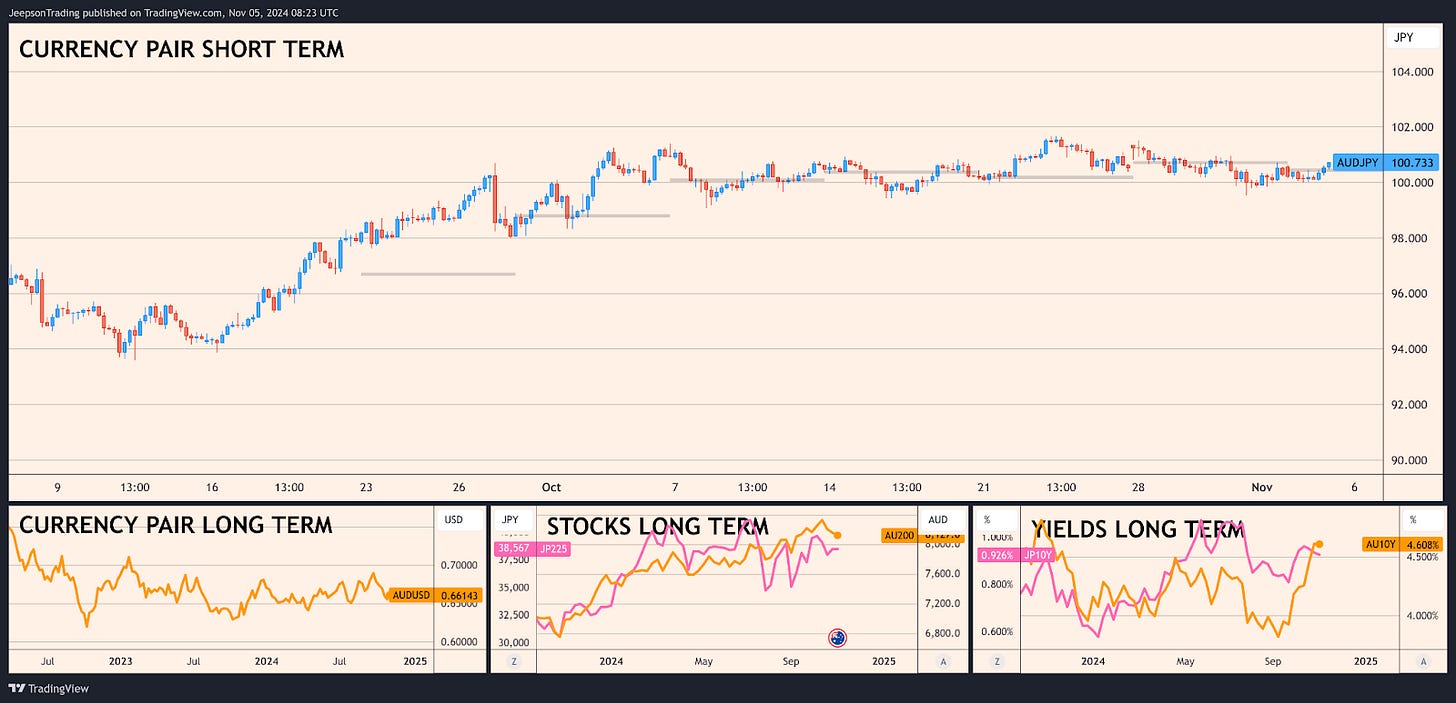RBA Holds Firm: Policy Divergence Defines AUD Outlook
Tuesday, November 5, 2024 (Week 45)
The Reserve Bank of Australia held interest rates steady at 4.35%, reinforcing its position as one of the more hawkish central banks among developed economies.
A Hawkish RBA
The Australian market's trajectory continues to be shaped by the RBA's steadfast monetary policy stance, contrasting sharply with growing expectations for rate cuts among other major central banks. In maintaining rates at 4.35% today, the RBA explicitly cited that while headline inflation has declined significantly to 2.8% in Q3 2024 from 3.8% in Q2, underlying inflation remains too high for comfort. The bank emphasised the need to maintain sufficiently restrictive policy until confident that inflation is sustainably moving toward the target range.
Emerging Theme
A significant shift in Australian employment dynamics has emerged as a key market focus. The most recent data shows a remarkable addition of 64,100 jobs in September 2024, substantially exceeding market expectations of 25,000, while maintaining an unemployment rate at 4.1%. This robust labour market performance, which the RBA specifically referenced in today's statement, contrasts with manufacturing sector weakness, as evidenced by the Judo Bank Manufacturing PMI remaining in contraction at 47.3 in October.
RBA Maintains Independent Course
The RBA's policy stance continues to maintain independence from global easing expectations. The central bank noted that while recent data shows inflation has declined significantly, its focus remains on the persistent strength in services inflation, which stood at 4.6% in the latest readings. This marks the eighth consecutive gathering where rates have been held at 4.35%, with the bank explicitly stating that monetary policy needs to remain "sufficiently restrictive."
Key Economic Indicators Signal Mixed Momentum
Growth (Q2 2024)
Actual: 0.2% QoQ growth
Expected: 0.3%
Market Impact: Growth remains at the softest pace in five quarters
Key Detail: Household spending contracted 0.2% after rising in prior quarters
Inflation (Q3 2024)
Annual Rate: 2.8%
Prior: 3.8%
Core Detail: Trimmed mean at 3.5%
Impact: Lowest reading since Q1 2021
Labor Market (September 2024)
Employment Change: +64,100 jobs
Full-time Component: +51,600
Participation Rate: 67.2% (record high)
Unemployment: Steady at 4.1%
Trade Performance (August 2024)
Balance: AUD 5.64 billion surplus
Export Movement: -0.2% MoM
Import Trend: -0.2% MoM
Notable: Largest surplus since April
Markets
The S&P/ASX 200's recent performance reflects the complex interplay of global and domestic forces. The index rose 0.56% to close at 8,165 on Monday, November 4th, with notable sector-specific movements in resources and banking stocks. Australian 10-year government bond yields reached 4.61%, indicating market repositioning around monetary policy expectations.
Upside Catalysts for AUD
RBA's reaffirmed hawkish policy stance
Demonstrated labour market strength
Trade surplus sustainability
Potential Chinese stimulus measures
Downside Catalysts for AUD
Global growth uncertainty
Manufacturing sector weakness
US election outcome implications
Rising geopolitical tensions
Conclusion: Policy Divergence Takes Centre Stage
The Australian dollar's near-term trajectory hinges on the market's interpretation of the RBA's steadfast policy stance against an increasingly complex global backdrop.
Key Takeaways:
RBA maintains hawkish stance with rates held at 4.35%, emphasising inflation vigilance
Labour market strength continues to provide fundamental support despite manufacturing weakness
US election and Chinese economic developments present near-term directional risks
Sources
Reserve Bank of Australia, Australian Bureau of Statistics, S&P Global, Trading Economics



